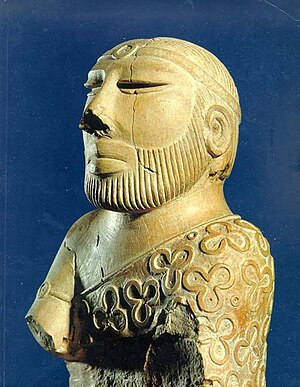User:Mel-akkam/sandbox
Cooperative State of Mel-akkam Sahakara Mel Akam | |
|---|---|
|
Flag | |
| Motto: Santi mariyu purogati | |
 | |
| Capital and largest city | Mohenjo-daro |
| Official languages | Dravidian |
| Recognised national languages | Punjabi Hindi English |
| Ethnic groups |
|
| Demonym(s) | Mel-akkan |
| Government | Unitary assembly-independent republic |
• Honoured Elder | Pujari Adhineta |
• President of the Coordinating Council | Nirtyam Am'mayi |
• Leader of the Government | Nirtyam Am'mayi (acting) |
| Legislature | Commissions → Coordinating Council |
| History | |
• Mehrgarh Established | ~7000 BCE |
• Organised by Pujari Nayaku | ~2600 BCE |
• Independence | 1947 |
| Area | |
• Total | 800,000 km2 (310,000 sq mi) |
| Population | |
• 2023 estimate | 509,120,056 |
• 2020 census | 473,621,972 |
| GDP (nominal) | 2020 estimate |
• Total | $3.18 trillion |
• Per capita | $13,514 |
| Currency | Bangle (bng) (BNG) |
| Date format | dd-mm-yy |
| Driving side | left |
| Internet TLD | .ml |
Mel-akkam, officially the Cooperative State of Mel-akkam (Dravidian; Sahakara Mel Akam), is a nation located in South Asia. It is a unitary assembly-independent republic; its capital and largest city is Mohenjo-daro.
Etymology
"Mel Akam" means literally "high country" or "highlands", referring to the Balochi mountains where the Mel-akkan people were believed to have originated. The Sumerians transliterated "Mel Akam" as "Meluhha", while the Vedic Indo-Aryans of the Oxus Civilisation referred to the Mel-akkan people as "Mleccha". "Mel-akkam", the usual romanisation of the country's name, was first used by the Portuguese explorer Vasco da Gama.
History
Ancient History
The first signs of Mel-akkan civilisation come from the ancient settlement of Mehrgarh, which was constructed around 7000 BCE and expanded into a full city around 4800. However, around 3500 BCE, the Saraswati River, which had provided water to the city, changed its course, and the people of Mehrgarh left, eventually establishing settlements along the new course of the Saraswati and along the river it now flowed next to, the Indus. The first of these was Harappa, located in the north of what would become Mel-akkam. For centuries, Harappa was the epicentre of Mel-akkan civilisation, with most other towns acting as vassals of the city; however, around 2700 BCE, a community leader named Pujari Nayaku, claiming that he had received a prophecy from the main Mel-akkan god, Pashupati, led a group of disciples to construct a meticulously planned city in the southern plains of Mel-akkam. The city, which became known as Mohenjo-daro, pioneered the ideology of “Purogati” (roughly “progress” or “progressivism”), an egalitarian system in which all citizens were encouraged to view others as equal in value to themselves, reinforced with the construction of completely identical houses for all citizens, as well as with the establishment of a distributive economic system in which all citizens willingly pooled their resources and, despite in some cases owning businesses, abandoned the idea of wealth-gathering. The success of this system, aided in no small part by the superb workmanship of Mohenjo-daro (which became the first city in the world where all houses had running water and flush toilets), led to the adoption of “Purogatinist” policies by nearly all of Mel-akkam. Thus, the centre of power gradually shifted from Harappa to Mohenjo-daro.
For reasons unknown even to Mel-akkan historians, Mel-akkans never conceived of the concepts of violence, murder, or warfare, as is evidenced by the fact that the Mel-akkans had no word for murder and instead resorted to calling it “vyaktia campadu” – “[livestock] culling of men”. The first Mel-akkans to encounter these practises, diplomats on a mission to Akkad, were recorded as having lamented about “what a tragic accident” some Akkadian soldiers had made, and upon learning the nature of the action, were bewildered and distraught. While increasing contact with other civilisations informed Mel-akkans of the existence of murder, to the present day Mel-akkans are known for being unable to comprehend why such a crime exists.
Vedic to Early Modern History
Around 1900 BCE, the Indo-Aryan residents of the Oxus Civilisation migrated south, passing through Mel-akkan land but largely ignoring its inhabitants, whom the Rigveda (the main oral tradition of early Indian history and religion) describes as the “incomprehensible” people of the land of “Mlechha”. However, around 1700 BCE, a massive famine caused large portion of the Mel-akkan populace to migrate to the Southeast, adopting Indo-Aryan cultural practises and becoming the various branches of the Dravidian people, with the first wave becoming the Tamils, the second the Kannada, and the third, whose language and culture remained somewhat less diluted, the Telugus. These groups established their own kingdoms in Southern India and largely abandoned the Purogatinist tradition.
During the Middle Ages, Mel-akkam experienced a golden age, enjoying a level of stability never seen in India, which was divided among warring states. This period of peace and prosperity began to deteriorate, however, after Mel-akkam was made a vassal of the Mughal Empire, which installed a series of puppet leaders seeking only to enrich themselves. Therefore, when the British East India Company began to colonise the subcontinent, Mel-akkam was easy prey. In 1678, Mel-akkam fell to the Company, which would rule over the former nation until 1858, when the Sepoy Rebellion led to the replacement of Company rule with direct rule by the United Kingdom, in what became known as the “British Raj”. Under the British Raj, Mel-akkam suffered greatly, with the high standard of living that Mel-akkans had enjoyed since the rule of Pujari Nayaku being reversed through intensive resource extraction and widespread forced labour.
Modern History
By the start of the 20th century, opposition to British rule had solidified not only in India but also Mel-akkam, and many Mel-akkans were drawn to Indian activist Mohandes (Mahatma) Gandhi’s nonviolent resistance movement, “Satyagraha”. Hence, in 1933, a group of Mel-akkans led by the activist Maina Kathina formed the Kaska Satyagraha Purogati – roughly, the “Progressive Nonviolence Movement”. This movement committed itself to nonviolence; however, in 1942, Kathina received an offer from Imperial Japan, delivered via Subhas Chandra Bose's Indian National Army. In exchange for collaborating with the Axis powers against the United Kingdom, Japan, and its puppet state, the Azad Hind, would provide for the establishment of a Mel-akkan state under Axis suzerainty, with Kathina at its helm. Attracted, Kathina abandoned the nonviolent tradition of the KSP, renaming it to simply the “Kaska Purogati” – “Progressive Party”, and declared herself the Netaji, or leader (a title borrowed from Subhas Chandra Bose), of the new “Free” Mel-akkam. A 1943 naval invasion of Mel-akkam by Japan allowed Netaji Kathina to rule (in a limited capacity) over 3 of the nation’s 10 traditional provinces. During the Japanese-Kathina period, a new social model – referred to posthumously as “Kathinism” – was established. All Mel-akkans were expected to become members of the Kaska Purogati, and democratic elections (planned, but never held), were to occur through the structures of the party. For the first time, a law enforcement agency was established, and equipped with weaponry. The former decentralised, technocratic model of administration was scrapped, and the Netaji’s word, often dictated from Tokyo, became law.
After only 2 years, however, the Netaji’s administration came to an end. In 1945, British forces invaded, ousting the Japanese, reestablishing the Raj, and executing Kathina for treason. Over the next 2 years, the Kaska Purogati reformed its structures and image, distancing itself from Kathina’s legacy and, by extension, that of the Axis, but resuming her fight against the British, albeit in a wholly nonviolent manner. Eventually, faced with pressure not only from the KP but also from Gandhi’s powerful Indian National Congress party, the British granted independence to the whole of British India, which soon split into three parts: Pakistan in the west, India in the east, and Mel-akkam between the two. During the Cold War, Mel-akkam pursued a policy of non-alignment, establishing close relations with India and Yugoslavia, and the Kaska Purogati became a dominant, albeit decentralised force, with its members frequently running against each other in elections. It remained the only political party in the nation until 1992, when the end of the Cold War inspired the creation of the centre-right Liberal Democratic Party. Gradually, other parties cropped up, representing ideologies as diverse as communism and right-wing populism. Ultimately, the Kaska Purogati would lose power to a succession of various new parties before splitting into three factions, none of which have successfully claimed the former juggernaut’s status.
Politics
Government
Foreign Relations and Military
Demographics
<imgur thumb="yes" w="250" comment="Population density of Satucinais municipalities.">FU7Xt4v.png</imgur>
Ethnic Groups
Languages
Religion
Urbanisation
| Rank | State | Pop. | Rank | State | Pop. | ||||
|---|---|---|---|---|---|---|---|---|---|
Gatôn  Pasau |
1 | Gatôn | Anniane | 10,340,927 | 11 | Saint-Chloé | Chloéterre |  Satau  Arac | |
| 2 | Pasau | Pasau | 12 | Faseun | Saufac | ||||
| 3 | Satau | Satau | 13 | Chaon | Parane | ||||
| 4 | Arac | Parane | 14 | Venant | Pasau | ||||
| 5 | Enot | Anniane | 15 | Chié | Malmonde | ||||
| 6 | Ticusa | Anniane | 16 | Malhivert | Nouveau Sessonis | ||||
| 7 | Claudeville | Îles Èmeraude | 17 | Saque | Sythes | ||||
| 8 | Bonhavre | Bonhavre | 18 | Cesse | Anniane | ||||
| 9 | Port Royal | Satau | 19 | Musseau | Satau | ||||
| 10 | Nouveau Sessonis | Nouveau Sessonis | 20 | Leuy | Chloéterre | ||||


